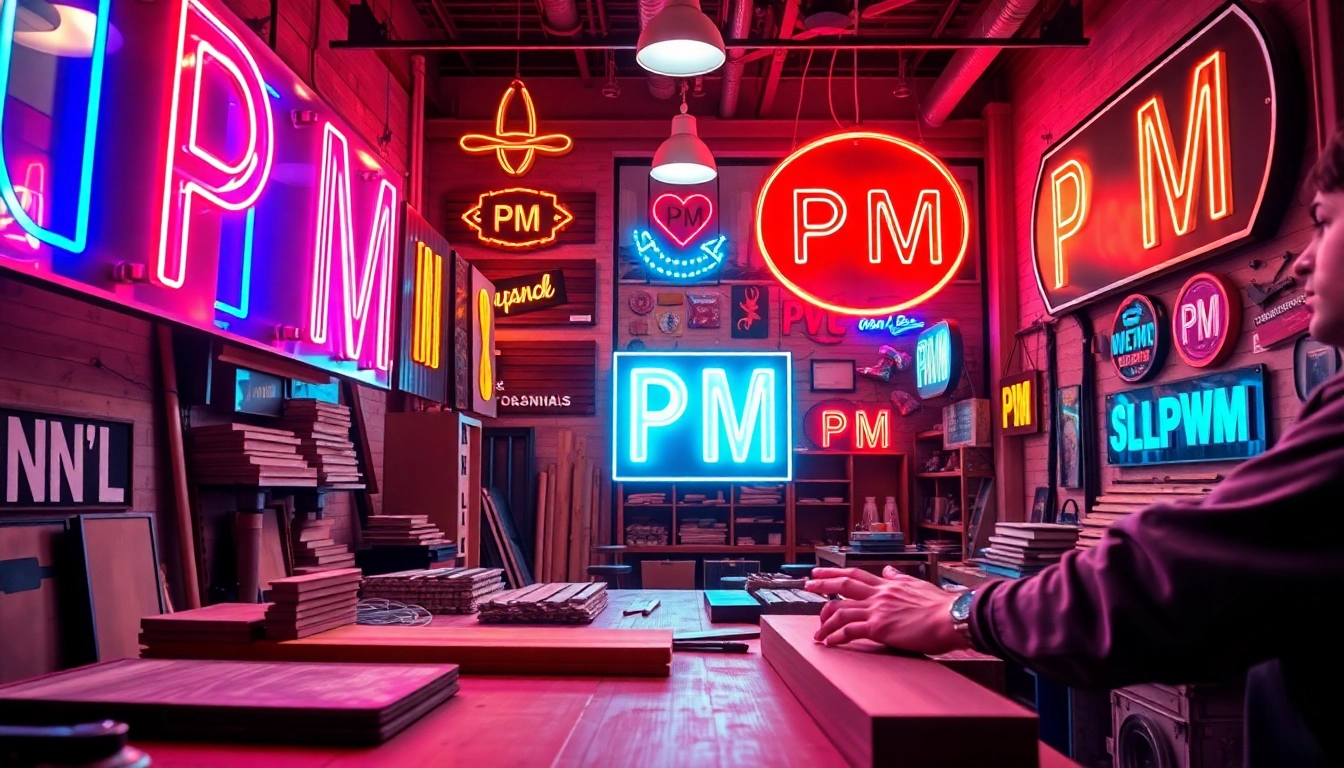Understanding PM Signs
Every business encounters the necessity of signage at some point, paving the way for effective communication with customers and facilitating brand recognition. PM signs play a vital role in this context, serving as both functional elements and aesthetic enhancements that reflect a company’s identity. By leveraging pm signs, brands create impactful representations that can either attract or dissuade potential customers. Let’s delve deeper into what PM signs encompass and why they are crucial to modern branding strategies.
The Importance of Signage in Branding
Signage is more than just visual representation; it’s an essential component of a brand’s identity. A well-designed sign communicates the essence of a business quickly and effectively, often being the first point of contact between a company and its customers. Studies suggest that approximately 76% of consumers have entered a store or business based solely on its sign. This statistic underscores the notion that signage can dramatically influence consumer decision-making and behavior.
Furthermore, consistent branding through signage reinforces brand recognition. Consistency in colors, fonts, and materials can enhance the overall perception and recall of a business. In a competitive marketplace, having distinctive and well-thought-out PM signs can be one of the most effective marketing tools available.
Types of PM Signs for Different Businesses
PM signs vary widely, catering to numerous sectors including retail, hospitality, corporate, and healthcare. The type of sign that a business chooses to utilize can convey specific messages and serve diverse purposes:
- Outdoor Signs: These signs are intended for external visibility and can range from storefronts and banners to billboards and monument signs.
- Indoor Signs: Effective for interior navigation, these include wayfinding signs, directional signs, and informational displays.
- Digital Signs: Equipped with LED technology, these signs allow businesses to display dynamic content, promotional messages, or important announcements in real time.
- Vehicle Signs: Vehicle wraps and decals transform company cars into mobile advertisements, extending visibility while on the move.
Understanding which type of sign aligns best with a business’s branding strategy is essential in creating effective visual communication.
Materials Used in PM Signs Manufacturing
The choice of materials for PM signs significantly impacts not only their durability but also their visual appeal. Some common materials used in the manufacturing of PM signs include:
- Vinyl: Ideal for graphics and banners, vinyl is weather-resistant and versatile, making it suitable for both indoor and outdoor applications.
- Aluminum: Lightweight and rust-resistant, aluminum signs are excellent for outdoor use, offering longevity and resistance to extreme weather conditions.
- Wood: For a classic and premium look, wooden signs can add a rustic charm, thus better aligning with certain branding strategies.
- Acrylic: This material is favored for indoor signs due to its sleek appearance and variety of available colors and finishes.
Choosing the right material based on the environment and intended use is crucial and can determine the sign’s effectiveness.
Designing Effective PM Signs
A well-designed PM sign not only captures attention but also effectively communicates the intended message. The design process requires a blend of creativity, understanding of visual hierarchy, and knowledge of branding principles.
Key Design Principles for PM Signs
There are several design principles that should be adhered to while creating PM signs. These include:
- Clarity and Simplicity: The message should be conveyed immediately. Avoid cluttered designs that confuse the audience.
- Hierarchy: Use size, color, and placement to create a visual hierarchy that guides the viewer’s eyes to the most important information first.
- Readability: Choose fonts that are easily readable from a distance. Consider letter height and spacing for optimal visibility.
- Consistency: Integrate your branding elements consistently across all signage to build recognizable and trustworthy brand identity.
Using Color Psychology in PM Signs
Colors evoke emotions and can significantly influence perceptions. Understanding color psychology can be pivotal in designing PM signs:
- Red: Associates with passion and urgency, perfect for sale promotions or attention-grabbing messages.
- Blue: Conveys professionalism, trust, and calmness, commonly used by corporate businesses.
- Green: Symbolizes nature and growth, ideal for environmentally friendly products or services.
- Yellow: Represents optimism and clarity, but should be used sparingly as it can be overwhelming.
Deciding on a color palette that aligns with brand identity and conveys the right message will optimize the effectiveness of PM signs.
Incorporating Branding Elements
Effective PM signs should reflect the brand’s identity. This can be achieved by incorporating elements like logos, taglines, and consistent color schemes. These elements ensure that the signage is not only a point of information but also a medium through which brand recognition is established. Integrating balanced design through proportion and alignment can enhance the professional look of the signage, further solidifying the brand’s presence in the market.
Installation and Maintenance of PM Signs
Once designed, the installation of PM signs becomes equally critical. Improperly installed signage can lead to poor visibility and safety hazards, hindering the signage’s effectiveness.
Professional vs. DIY Installation
While DIY installations can seem cost-effective, they may lead to various complications.
- Professional Installation: Hiring professionals guarantees that the sign is mounted securely, compliant with local regulations, and positioned for maximum visibility.
- DIY Installation: Though cost-effective, this may result in mistakes such as misalignment or poor material handling, ultimately affecting the intended purpose of the sign.
The complexity of a signage project should determine the choice between professional help and DIY methods. For high-traffic locations or larger signs, professional installation is generally recommended.
Best Practices for PM Signs Maintenance
Maintaining signage is crucial for sustaining its quality and effectiveness. Regular maintenance checks can help address issues like fading, discoloration, or damage due to weather conditions. Some best practices include:
- Regularly clean signs to remove dirt, grime, and debris.
- Check for any structural issues or damage, particularly after heavy storms or adverse weather.
- Evaluate lighting conditions for illuminated signs to ensure they remain visible at night or in low-light areas.
Seasonal Considerations for Outdoor PM Signs
Seasonal changes can have significant impacts on the integrity of outdoor PM signs. For instance:
- Winter weather, such as snow and ice, can weigh down signs or obscure visibility.
- Heavy rains can cause water damage or rust if the materials used are not waterproof.
- Summer heat can lead to color fading and material wear, necessitating the choice of high-quality, UV-resistant materials.
Planning for seasonal maintenance can prolong a sign’s life cycle and maintain aesthetic appeal throughout the year.
Regulatory Considerations for PM Signs
Before implementing signage, it is vital to navigate through local regulations to ensure compliance, as failure to adhere can result in fines or the need to remove the sign.
Understanding Local Signage Regulations
Local governments have specific laws governing the size, type, placement, and lighting of signs within particular zones. Businesses should regularly consult with local zoning boards or municipal guidelines to remain compliant and avoid penalties.
Adhering to Visibility Guidelines
Visibility guidelines outline standards for readability, placement, and height to ensure that signs are not only visible but do not obstruct traffic or pedestrian flow. This entails maintaining specific distances from curbs and ensuring line-of-sight requirements are met.
Common Violations to Avoid
Being aware of common violations can help businesses avoid unnecessary fines. Issues such as improper installation in restricted zones, inadequate visibility, or violating local sign size regulations can lead to costly consequences. Conducting thorough research and seeking proper permits before installation is essential.
Case Studies: Successful PM Signs Implementations
Examining case studies can provide valuable insights into the practical applications of PM signs and their impact on business growth.
Business Growth Stories with PM Signs
For example, a local coffee shop in a busy downtown area redesigned its signage to better reflect its brand identity. By choosing bold colors and a minimalist design that incorporated its logo, they increased foot traffic by 40% within two months. The attention-grabbing sign acted as a beacon, driving new customers to the establishment.
Innovative PM Signs that Captured Attention
Another noteworthy case involved a retail clothing store that utilized digital signage to display on-trend items and promotional sales. The dynamic content adjusted regularly based on target customer engagement, driving sales up by 25% during its first three months of implementation.
Lessons Learned from PM Signs Projects
Each case study emphasizes the importance of thoughtful sign design, material selection, installation, and adherence to regulations. Just as crucial is the need for ongoing assessment of signage effectiveness, allowing brands to refine their approaches based on consumer feedback and evolving market trends.















Leave a Reply